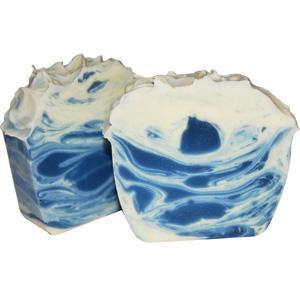 We were in the cold process soaping kind of mood, and we were inspired by the scent Blueberry Cheesecake Fragrance Oil. We wanted to do something different and add a little extra element to the recipe really challenging our soap making capabilities. Obviously, since the scent was a cheesecake type fragrance oil, the go to ingredient in our minds was Cream Cheese; a vital piece to any cheesecake recipe.
We were in the cold process soaping kind of mood, and we were inspired by the scent Blueberry Cheesecake Fragrance Oil. We wanted to do something different and add a little extra element to the recipe really challenging our soap making capabilities. Obviously, since the scent was a cheesecake type fragrance oil, the go to ingredient in our minds was Cream Cheese; a vital piece to any cheesecake recipe.
The first step we took was to set the cream cheese out for a few hours so that it would be room temperature when we added it to the soaping oils (before the addition of lye water). We figured this was a logical step since you do the same thing when you make real cheesecake. In the first recipe that we tried, the cream cheese portion was 25% of our water amount; we figured we would go for the gusto.
We had already made our concentrated lye solution; it was cooling down. Our soaping butters and oils were also in a melted state. So, while we played the waiting game; we placed the cream cheese into the melted oils to allow the heat to soften up the cream cheese even further. And, it did just that. Using a spatula we were further able to break up the cream cheese. This was the first real visible hitch that we had. Once the cream cheese was broken up in our soaping oils the appearance was a little different than what we had anticipated. The cream cheese basically looked like it was ricing in our bowl.
We still proceeded as normal, and once the temperatures were correct to add the lye solution into the soaping oils, we did just that. Once the stick blender was introduced into the equation, the riced look was no longer a problem. The cream cheese was completely emulsified as was the rest of the soaping batter. We were golden.
As for any other special elements for this recipe; due to the fact that Blueberry Cheesecake Fragrance Oil discolors, we also added vanilla white color stabilizer to help reduce discoloration in our finished soap. This was added at a 1 to 1 ratio. We also desired to make this soap look identical to real blueberry cheesecake. So, besides the colorants used to make the deep bluish hue, we also used titanium dioxide to whiten the “cheesecake” portion of the soap.
There were no other hiccups as we proceeded with the rest of the soaping recipe. Once the batter was pot swirled and poured into the molds, we allowed it to sit undisturbed; playing the waiting game once again.
Flash Forward: After the soap sat in the mold for 24 hours, we unmolded it. The soap showed promise with beautiful outside coloration. We were very excited to cut the loaf and see how the pot swirl had turned out. After slicing a few of the bars, we were in awe of the delightful thick swirls running throughout each bar we sliced. That was when we noticed the foul smell coming from the freshly sliced soap. The blueberry cheesecake scent was very evident, but the soap also had a strange aroma to it. Our first thought was the cream cheese. Was it possible that the cream cheese had some kind of reaction during the soaping process? We were not sure. So, we reviewed the recipe, ran it through soap calc again, and came to the realization that 25% was too high of a percentage of cream cheese. So, we were going to try the recipe again.
The next day we reworked our numbers. This time we only added 20% cream cheese, and we corrected our water portion amount. Everything else was exactly the same. After the soaping process and mold time, once again we were in the same boat. The new cut soap also had that strange foul odor to it. Another great learning experience for us; but it was still a failure when it came to mastering the cream cheese recipe.
Not wanting to throw the proverbial towel in yet; we tried the cream cheese soap recipe one last time. For this we held the cream cheese at 20% but this time we soaped at the lowest temperature possible. Knowing the the third time is a charm, and hyped that we may have just salvaged the soap recipe, we anxiously sliced the first piece… and with the bar came that smell.
Finally, we decided that soaping with cream cheese is a lot like soaping with butter; finicky butyric acid!
Taking a step back, we still really liked the quality of the bars, even with the smell. We noticed that the bars from our first recipe still had the odor, but it was not as strong. It seemed to dissipate as the bars cured; saving us from complete disaster. However, not wanting to settle, the Blueberry Cheesecake Fragrance deserved a much better recipe to truly highlight its mouth-watering aroma.
We ended up making the Blueberry Cheesecake Cold Process Soap Recipe again. However, this time we used 2% milk instead of cream cheese. Since we had soaped with dairy before with the Cleopatra Cold Process Soap Recipe (heavy whipping cream) and the Caramel Custard Cold Process Soap Recipe (evaporated milk), we went with a 50% water and 50% frozen milk portion.
In true soaping with dairy fashion, we froze the weighed out milk portion and added it straight to the melted butters and oils. We then proceeded with adding the lye water and so on. There were no issues with this recipe. We were very happy with the in pot swirl and final colors in our soap bars. With all of the coloring practice we had with this recipe; it was spot on! The performance of the finished bars themselves were great; full of lather, lightly exfoliated, and moisturized the skin. Overall, even with the few hiccups we had with the cream cheese, it was all worth it in the end.
To view the full Blueberry Cheesecake Cold Process Soap Recipe, you can simply click on the link. This recipe or any of the recipes mentioned in this blog post are also listed under the Free Recipes and Classes Section of Natures Garden’swebsite categorized under Cold Process Soap Recipes.

